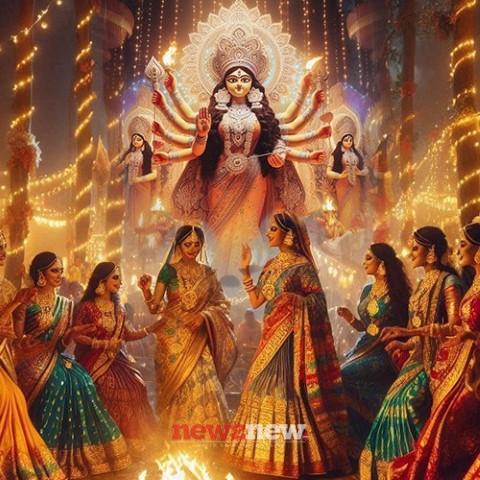Contents
Celebrate Navratri 2025: Complete Ritual Guide, Shubh Muhurat & Vrat Timings for a Blessed Festival: Navratri 2025 will be celebrated from September 22 to October 2, marking ten days of spiritual devotion, ritual fasting, and cultural festivities honouring Goddess Durga and her nine divine forms.
 Below is a complete guide of Navratri 2025 Shubh timings, vrat timings, and the actual rituals for celebrating the festival according to tradition.
Below is a complete guide of Navratri 2025 Shubh timings, vrat timings, and the actual rituals for celebrating the festival according to tradition.
Navratri 2025 starts on Monday, September 22, and ends with Vijayadashami (Dussehra) on October 2. The festival’s first major ritual is Ghatasthapana (Kalash Sthapana), observed on the Pratipada Tithi.
- Ghatasthapana Shubh Muhurat: September 22, 2025, from 06:09 AM to 08:06 AM (Kanya Lagna). If missed, Abhijit Muhurat (11:49 AM to 12:38 PM) can be chosen.
- Pratipada Tithi: Starts September 22, 2025, 01:23 AM, ends September 23, 2025, 02:55 AM.
- Festival Conclusion: Dussehra or Vijayadashami is observed on October 2, 2025.
Daily puja can be performed between 6:00 AM – 8:30 AM and again from 6:30 PM – 8:00 PM for best spiritual benefits.
Devotees observe the Navratri fast (Vrat) from Pratipada (Sept 22) to Navami (Sept 30), during which only sattvic meals—without grains, onion, or garlic—are consumed. Those fasting for all nine days must:
- Start with prayers and resolve (Sankalp) on Day 1 after Ghatasthapana.
- Eat only fruits, milk, and foods made from buckwheat flour, water chestnut flour, and sabudana.
- Avoid alcohol, non-veg, and grains; maintain purity in thoughts, speech, and actions.
- Break the fast after Navami Puja and Kanya Pujan.
-
Ghatasthapana or Kalash Sthapana
This marks the spiritual inauguration of Navratri. The Kalash symbolizes the abode of Goddess Durga’s energy, and its installation invites divine blessings into the home.
- Preparation: Clean the puja area. Spread clean soil in a clay or brass pot, sow seven or nine types of grains (Sapta/Nava Dhanya).
- Kalash Setup: Fill the earthen or metal Kalash with sacred water (preferably Ganga jal), add rice, coins, turmeric, betel nuts, and a red sacred thread (Kalawa) around its neck.
- Decoration: Arrange five mango leaves atop the Kalash and place a coconut wrapped in red cloth on top. Draw a Swastika using turmeric or vermillion.
- Invocation: Place the Kalash centrally in the puja space, light a diya, and offer flowers, rice, kumkum, sandalwood, and chant Durga Mantras to invoke the Goddess.
-
Akhand Jyoti
Light an Akhand Jyoti (eternal flame) beside the Kalash to symbolize the Goddess Durga’s perpetual energy and protection throughout Navratri.
-
Daily Puja and Offerings
Each day is dedicated to a specific form of Goddess Durga—the Navadurgas—and the puja sequence includes:
- Bathing and wearing clean clothes
- Offering fresh flowers, fruits, and sweets
- Reciting Durga Chalisa, Devi Mahatmyam (from Markandeya Purana), and Navdurga mantras
- Performing aarti and singing devotional songs
-
Observing Colours and Foods
Follow the auspicious colour of the day, which resonates with the energy of each Goddess. For example, Day 1 for Maa Shailputri—Yellow, Day 2 for Maa Brahmacharini—Green, and so forth.
Offer prasad-items corresponding to the day’s deity:
- Day 1: Ghee for peace and stability
- Day 2: Sugar and fruits for success and courage
- Day 3: Milk/kheer for family harmony
- Continue with devotional offerings based on tradition.
On the ninth day (Navami), conduct Kanya Pujan—worship nine young girls symbolizing the nine forms of Durga. Feed them, give gifts, and seek their blessings.
-
Immersion/Vijayadashami (Dussehra)
Navratri ends with a grand aarti and immersion of the Kalash or idol on Dussehra (October 2, 2025), celebrating Durga’s victory over Mahishasura, symbolizing the triumph of good over evil.
 Regional Celebrations and Cultural Festivities
Regional Celebrations and Cultural Festivities
- Durga Puja (West Bengal): The last three days are celebrated with Kalparambha, Bilva Nimantran, Kumari Puja, and Sandhi Puja, culminating in elaborate pandal visits.
- Garba and Dandiya (Gujarat and Maharashtra): Evening dance gatherings set to devotional music, symbolizing joy and devotion.
- Bommai Golu (South India): Worship involves creative arrangement of dolls and cultural storytelling.





 Navratri Vrat Timings, Rules, and Fasting
Navratri Vrat Timings, Rules, and Fasting
